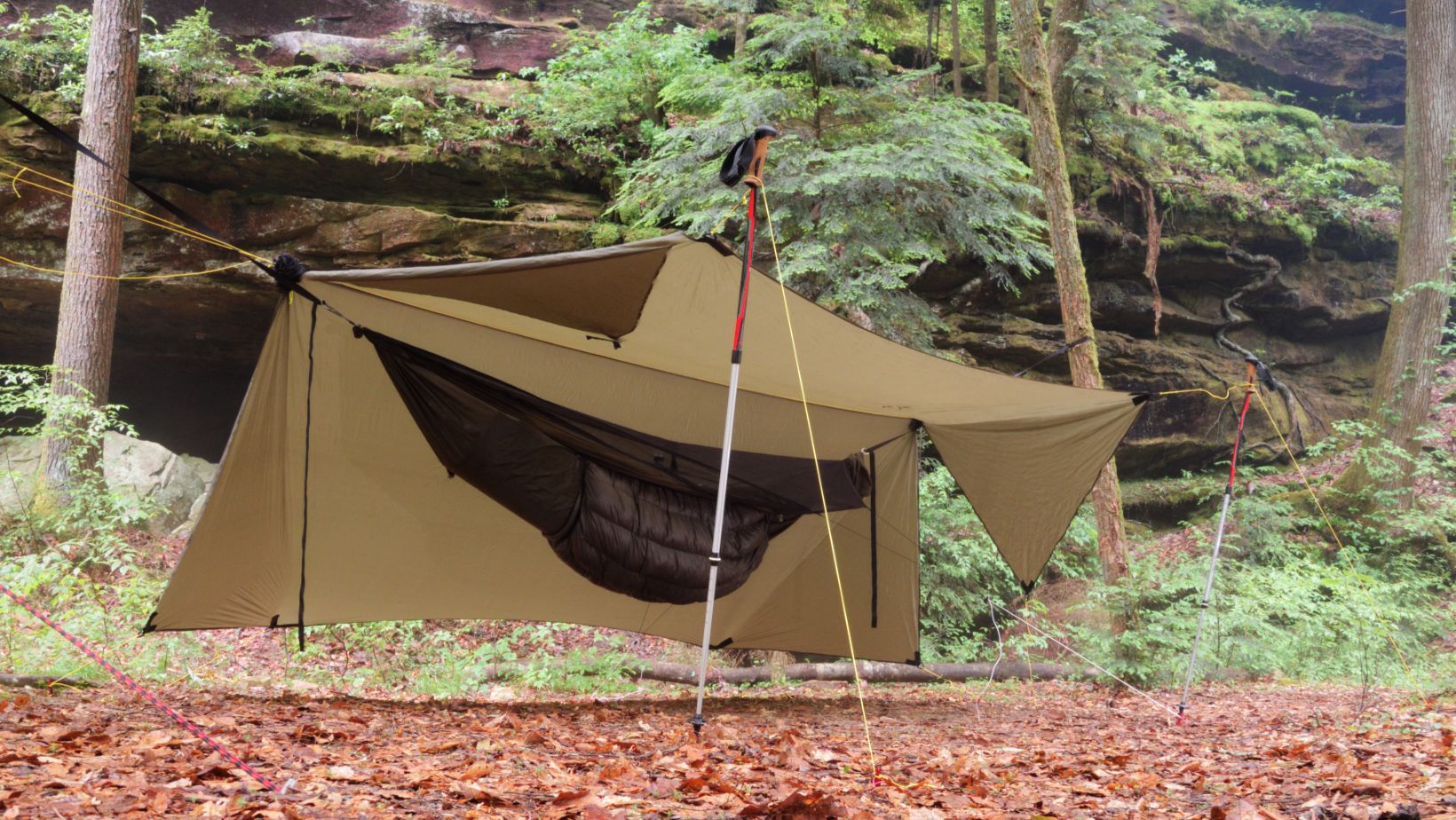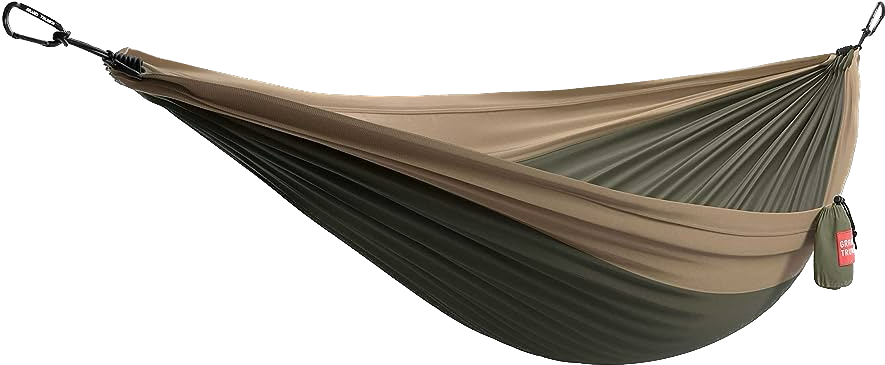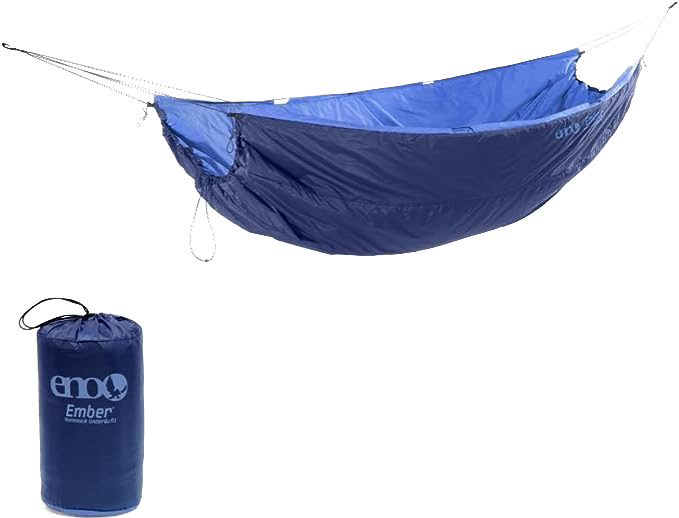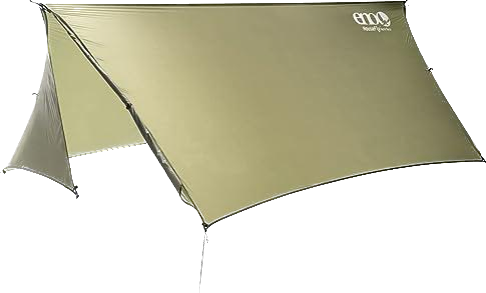For those starting to get into hammocking, guy lines may not be a term or tool that you’re familiar with. However, they’re a fantastic piece of equipment to bring on your next hammock camping trip. Let’s go through the basics of guy lines, how to use them, and the benefits of packing one.
Short Summary – What Are Guy Lines for Hammocking
Guylines are cords or ropes used in outdoor setups for tents, tarps, and hammocks to provide stability and support. They attach to structures and anchor points, helping to prevent swaying, shifting, and toppling.
Guylines play a vital role in helping these various outdoor equipment withstand harsh and wet weather conditions.
- Hammock guy lines provide stability, flexibility, and protection.
- Essential components of a guy line system include ropes, tension adjusters & ground stakes.
- Advanced techniques such as high hammocks and superfly tarps can add versatility and extra weather protection to the experience.
What Are Guy Lines?

Guy lines serve as versatile cords or anchoring equipment that provide stability, support, and tension to various structures, including hammocks and tents.
Guy lines are commonly made from lightweight yet durable materials such as nylon or polyester, which offer both strength and flexibility. Not to be confused with whoopie slings, a guyline’s distinct purpose is to prevent swaying, shaking, or collapsing of outdoor shelters, thereby enhancing comfort and safety during camping, backpacking, or relaxation activities.
That said, guylines have different uses. Mainly for tents, hammocks, and tarp guylines.
How Hammock Guy Lines Differ from Tent Guy Lines
While guyline uses might seem similar across different setups, the way guy lines are utilized can vary significantly between tents, hammocks, and tarps due to the distinct demands posed by each structure.
Let’s dive more into the differences between the uses of guylines and setups:
- Tent guylines are designed to secure and stabilize the tent against windy conditions and stormy weather. Additionally, a tent guyline cord is often thicker and stronger to handle the added tension and stress caused by the tent structure.
- Hammock guylines, on the other hand, are used primarily for suspension and stability of a hammock system while camping. A hammock guyline system is typically more thin and light since they don’t need to support the weight of a full tent and its occupants.
- Tarp guylines are tailored to secure the tarp’s edges, preventing flapping and shifting that can compromise the shelter’s coverage. While not required to bear the weight of occupants like tent guylines, tarp guylines must still maintain the tautness needed to ensure the tarp’s effective protection. They can be used in conjunction with tarp stakes to better stretch the tarp across your tent or hammock.
Overall, tent guy lines that often focus on anchoring the tent’s body for wind resistance, hammock guy lines primarily cater to maintaining the right sag, angle, and balance of the hammock itself. While tent guy lines emphasize tautness to brace against lateral forces, hammock guy lines balance tension with flexibility to ensure a comfortable and ergonomic cocooning effect.
Additionally, due to the distinct anchoring points of hammocks (trees or hammock stands) compared to tents (stakes or ground), the methods of attachment and adjustment also set these two types of guy lines apart.
Components of a Hammock Guy Line System

The setup of a hammock guy line system is mainly made of three main components:
- Ropes
- Tension adjusters (Line locks and tie outs)
- Ground stakes.
Attached ropes provide proper tension so the hammock stays firmly fastened with minimal risk of slipping or sliding on sloped terrain. Ground stakes are used as anchor points for stability and securing all rope lengths. They can also be used to make fine-tune adjustments based on personal preference for how taut you want your lines to be when setting up camp.
As long as you understand how each component works, you should be able to build an ideal set up, perfectly tailored towards your needs.
Choosing the Right Rope or Cordage
At the heart of the system lies the guy line cord, a versatile and durable length of rope or cordage.
Typically crafted from materials like nylon, polyester, or Dyneema, the cord provides the necessary strength to anchor the hammock securely. Its length and thickness influence the overall tension and stability of the setup, allowing you to adjust the hang to your preference.
Guy line cords are available in various lengths, enabling you to tailor your system to different hanging distances and anchor points.
When searching for an appropriate cordage to use as a guy line system, it’s important to consider 4 key things:
- Material
- Diameter
- Weight Capacity
- Strength
- Knotability
Common materials used for guy line cords include nylon, polyester, and Dyneema. These materials have good elasticity and strength while having good UV resistance. Dyneema has great strength-to-weight ratio and low stretch – which is ideal if you’re backing for staying the night.
A highly recommended choice is the 1.5-mm Kelty Triptease LightLine which offers durability and easy usability– making it ideal for hammockers who want reliable support and security.
Ultimately, your choice of rope should align with your preferences and demands of your hammock camping style. Whether you prioritize durability, weight savings, ease of use, or a combination of factors.
Line Locks and Tie Outs
Guy lines have line locks and tie-outs to help secure the connection to the hammock and adjust the tension. This helps get the “right hang” by pulling or loosening the tension.
Typically line locks and tie-outs are composed of rope, webbing, cord or bungee cords. These allow for easy adjustments but can be difficult to install correctly.
Just be aware, line locks and tie-outs can be damaged by the weather over time and use. Similar to hammock straps, keep an eye out for wear and tear. If left unchecked, the damage could break leaving you and your gear exposed.
Stakes and Anchors
Stakes and anchors provide the crucial foundation for a secure and comfortable setup.
Their primary function is to create a stable connection between your hammock and the surrounding environment, ensuring that your suspension remains taut, balanced, and reliable. Not to mention they help prevent you from twisting and swaying while in your hammock.
Setting Up Your Hammock Guy Lines

Setting up your guy lines on a hammock is easy with 8 simple steps:
- Identify Attachment Points
- Choose Your Attachment Method
- Tie Knots to Attach the Guyline System to Your Hammock
- Adjust the Length the Guyline
- Repeat for Each Attachment Point
- Even Out Tension Between the Guylines
- Test for Stability
- Fine-Tune Tension
Whether you’re already familiar or new to guylines, we’ll walk you through to understand some of the best ways to secure all the connecting points. So let’s look at each step more closely so that we get everything right when preparing our setup.
How to attach your Guy Line to Your Hammock
Attaching guylines to your hammock is a fundamental step in creating a stable and secure setup for your outdoor relaxation. Guylines provide the necessary tension and balance that keep your hammock properly aligned and prevent excessive swaying. Here’s a step-by-step guide on how to attach your guyline to your hammock using common methods:
- Identify Attachment Points: Locate the attachment points on your hammock where you will be connecting the guylines. These attachment points are typically D-rings, loops, or designated webbing straps near the hammock ends.
- Choose Your Attachment Method: Depending on your preferences and the features of your hammock, choose one of the following attachment methods:
- Loop Attachment: If your hammock has built-in loops or webbing straps, you can create a loop by passing the guyline through the loop or around the strap. This loop will serve as the connection point for your guyline.
- D-Ring Attachment: If your hammock has D-rings, pull the guyline through the D-ring, creating a loop or knot that securely attaches the guyline to the D-ring.
- Tie Knots to Attach the Guyline System to Your Hammock: If your attachment point doesn’t involve a loop or D-ring, tie a secure knot that ensures the Guyline won’t come loose. Basic knots for attaching guylines include the bowline knot, taut-line hitch, or clove hitch.
- Adjust the Length and Tension in the Guyline: Leave enough slack in the Guyline to accommodate adjustments later. The amount of slack you leave will depend on the specifics of your setup, the height of your hammock, and personal preferences.
- Repeat for Each Attachment Point: Repeat the above steps for each attachment point on your hammock. Most hammocks have multiple attachment points, and it’s essential to attach guylines to each one to ensure even tension and stability.
- Even Out Tension Between the Guylines: Once all guylines are attached, ensure that the tension on each line is even. This ensures that your hammock hangs level and balanced.
- Test for Stability: Gently sit or lie in your hammock to test the stability of the setup. If the hammock feels unstable or off-balance, make necessary adjustments to the tension of the guylines.
- Fine-Tune Tension: If your hammock has tensioning mechanisms like line tensioners or friction hitches, use them to fine-tune the tension of your guylines. Adjust the tension until you achieve the desired hang angle and sag for your hammock.
By following these steps and choosing appropriate attachment points and knots, you’ll be well on your way to enjoying a relaxing hammocking experience in the great outdoors.
Additional Tips for Hammocking with Guylines

Now that you have the basics of guylines and how to set them up, here are a few bonus tips that can help bring your hammock camp to the next level.
Using a Clothes Line
When camping, you can use your guy lines and incorporate a clothesline to effectively dry wet garments.
Of course, it’s important for the line to be secured safely onto the hammock before tying it off with a taut line hitch. After that, you just have to attach your articles of clothing using clips or pins. Once it’s all set up properly, simply adjust as needed until you have your desired tension.
Doing this provides an efficient way for drying clothes and free yourself up from time-consuming duties, letting you better enjoy nature’s outdoorsy experience!
Set up your Guylines to Avoid Tripping
When hammocking, it is important to remain aware of the chance for tripping hazards posed by guy lines.
To make them easier to see and avoid while out in nature, use brightly colored or reflective cordage when setting up your hammock.
Ensure all of the lines stays taut and nothing is drooping down-as this reduces risk even further.
Setting Up a High Hammock
Setting up a high hammock requires making use of longer guy lines and stakes, as well as establishing a secure knot like the taut-line hitch. Trees, rocks, or other objects might be necessary to provide enough support and stability for this type of setup.
A higher-positioned hammock allows you to experience something unique while being better protected against animals dwelling on the ground. That being said, be extra careful in high hammock setups, and don’t go any higher than you’re willing to potentially fall from.
Using a Superfly Tarp

If you’re needing a hammock tarp, try a superfly tarp. Adding a superfly tarp to your hammock setup can make a considerable difference in your outdoor experience.
A Superfly tarp is a type of hammock tarp that offers extended coverage and additional features such as multiple guy-out points, providing better protection against the elements, and versatile setup options compared to a regular hammock tarp, which typically provides more basic coverage.
When fixing the superfly tarp onto the guy lines of your hammock use a sturdy knot, like a taut line hitch. These knots should have a secure hold if bad weather rolls in.
What Size Tarp for Hammock Guyline?
A tarp of 8 feet in length (2.43 m) should be enough to provide a 6-12 inch protective guard on either side of the hammock’s guy line. In cooler climates or heavy downpours, utilizing a larger-sized tarp would offer greater coverage and protection for users.
Summary
In summary, guylines are a useful and versatile equipment item that can help secure your hammock, tarp, and tent. Hopefully, this guide was helpful in giving you all the tips you need to understand what guylines are and how to use them.



 Hello there, we're Vira Outdoors!
Hello there, we're Vira Outdoors!

